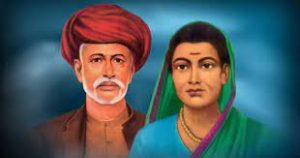09 Mar 2022 Savitribai and Jyotirao Phule

Savitribai and Jyotirao Phule – Today Current Affairs
- Recently, the Governor of Maharashtra was criticized for allegedly mocking the “young marriage” of 19th century social reformers Savitribai and Jyotirao Phule.
- Mahatma Jyotirao and Savitribai Phule are counted as an extraordinary couple in the social and educational history of India.
- She acted as a pioneer in the direction of women’s education and empowerment and in ending caste and gender based discrimination.
Today Current Affairs
Savitribai and Jyotirao Phule:
- In the year 1840, when child marriage was a common practice, at the age of 10, Savitribai was married to Jyotirao, who was then 13 years old.
- In later times the couple opposed child marriage and also advocated widow remarriage.
Jyotirao Phule: The Hindu Analysis
- Jyotirao Phule was an Indian social activist, thinker, anti-caste social reformer and writer from Maharashtra.
- He is also known as Jyotiba Phule.
- Education: In the year 1841, Phule was enrolled in the Scottish Missionary High School (Pune), where he completed his education.
- Ideology: His ideology was based on liberty, egalitarianism and socialism.
- Phule was influenced by Thomas Paine’s book ‘The Rights of Man’ and believed that the only way to combat social evils was to provide education to women and the lower classes.
- Major Publications: Tritiya Ratna (1855); Powada: Chhatrapati Shivajiraj Bhonsle Yancha (1869); Ghulamgiri (1873), Shaktarayach Asud (1881).
- Title of Mahatma: On May 11, 1888, he was honored with the title of ‘Mahatma’ by Vithalrao Krishnaji Vandekar, a social worker from Maharashtra.
- Social Reforms: In the year 1848, he taught his wife (Savitribai) to read and write, after which the couple opened the first indigenously run school for girls in Pune, where they both taught.
- He believed in gender equality and followed his beliefs by involving his wife in all his social reform activities.
- By the year 1852, Phule had established three schools, but due to lack of funds after the revolt of 1857, these schools were closed by the year 1858.
- Jyotiba understood the plight of widows and established an ashram for young widows and eventually became an advocate of the idea of widow remarriage.
- Jyotirao opposed the orthodox beliefs of Brahmins and other upper castes and termed them as “hypocrites”.
- In the year 1868, Jyotirao decided to build a mass bath outside his house, to reflect his sense of belonging to all human beings, along with that he started eating with members of all castes.
- He started an awareness campaign which eventually led to Dr. B. Ambedkar and Mahatma Gandhi, who later took a major initiative against caste discrimination.
- Many believe that it was Phule who was the first to use the word ‘Dalit’ to depict the oppressed masses who were often excluded from the ‘Varna system’.
Savitribai Phule: The Hindu Analysis
- In the year 1852, Savitribai started ‘Mahila Seva Mandal’ to raise awareness about the rights of women.
- Savitribai called for a Mahila Sabha, where members of all castes were welcomed and all were expected to sit on the stage together.
- He published ‘Kavya Phule’ in the year 1854 and ‘Bavan Kashi Subodh Ratnakar’ in the year 1892.
- In her poem ‘Go, Get Education’ she urges oppressed communities to get education and break free from the chains of oppression.
- They campaigned together against child marriage while supporting widow remarriage.
- They started the first Satyashodhak marriage in the year 1873 – marriage without dowry, Brahmin priest or Brahminical custom.
His legacy: The Hindu Analysis
- In the year 1848, Phule started a school in Poona for girls, Shudras and Ati-Shudras.
- In the 1850s, the Phule couple started two educational trusts—the Native Female School (Pune) and the Society for Promoting the Education of Mahar—which included several schools.
- In the year 1853 he opened a care center for pregnant widows for safe delivery and to end the practice of infanticide due to social norms.
- Bal hatya Prabandhak Griha (Infant Killing Prevention Home) started in his own house.
- Satyashodhak Samaj (The Truth-Seekers Society) was founded on September 24, 1873 by Jyotirao-Savitribai and other like-minded people.
- He advocated social changes in the society and took steps against the prevailing traditions which include economic marriage, inter-caste marriage, abolition of child marriage and widow remarriage.
- Simultaneously, Satya Shodhak Samaj was established with the aim of imparting education to the low caste, scheduled caste, scheduled tribe and making them aware of the exploitative tradition of the society.


No Comments